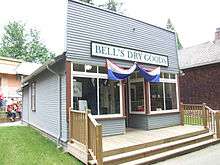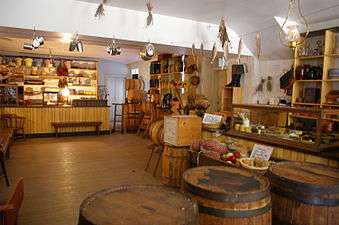Dry goods
Dry goods is a historic term describing the type of product line a store carries, which differs by region. The term comes from the textile trade, and the shops appear to have spread with the mercantile trade across the British colonial territories (and former territories) as a means of bringing supplies and manufactured goods to far-flung settlements and homesteads that were spreading globally. Starting in the mid-18th century, these stores began by selling supplies and textile goods to remote communities, and many customized the products they carried to the area's needs. This continued to be the trend well into the early 20th century. With the rise of department stores and catalog sales, the decline of dry goods stores began, and the term has largely fallen out of use.

Commonwealth and Philippines usage

In Commonwealth countries and the Philippines, dry goods are dry (dried, preserved) food items which have a years-long or indefinite shelf-life. They are "dry" because they are not stored in a preserving anti-fungal or anti-bacterial liquid which fully wets the preserved goods. The "dry goods" usage is made with reference to pre-refrigeration days of the early 20th century. Such foods could be transported and stored without immediate danger of spoiling, and without the extra weight and fragility of waterproof glass or ceramic containers.[1] Dried beans, flours, whole grains, and rolled oats are examples of this type of dry goods.[2]
US usage

In the United States, dry goods are products such as textiles, ready-to-wear clothing, and sundries.[3] In US retailing, a dry-goods store carries consumer goods that are distinct from those carried by hardware stores and grocery stores.[3]
Dry goods as a term for textiles dates back to 1742 in England[3] or even a century earlier.[4] Dry goods can be carried by stores specializing only in those products (a type of specialty store), or may be carried by a general store or a department store.[5]
Beginning in the early 20th century, many dry goods stores expanded into other lines of merchandise, and the term largely disappeared from both everyday usage and the official names of the businesses concerned.
References
| Look up dry goods in Wiktionary, the free dictionary. |
- "dry goods Meaning in the Cambridge English Dictionary". dictionary.cambridge.org.
- Dry Goods Economist. J. Mackey. 1917.
- Cole, George S. (1892). "Dry Goods". A Complete Dictionary of Dry Goods. Chicago: W. B. Conkey Company. 19th-century book about fabrics.
- Definition of "dry goods" from Merriam-Webster.
- "Retail middlemen of consumer goods". marketing-howto.com. Archived from the original on 2008-09-24.